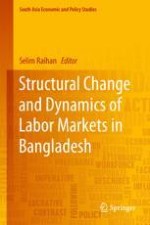2018 | OriginalPaper | Chapter
What Determines the Choice Between Farm and Nonfarm Employments in the Rural Bangladesh?
Authors : Selim Raihan, Syer Tazim Haque
Published in: Structural Change and Dynamics of Labor Markets in Bangladesh
Publisher: Springer Singapore
Activate our intelligent search to find suitable subject content or patents.
Select sections of text to find matching patents with Artificial Intelligence. powered by
Select sections of text to find additional relevant content using AI-assisted search. powered by
